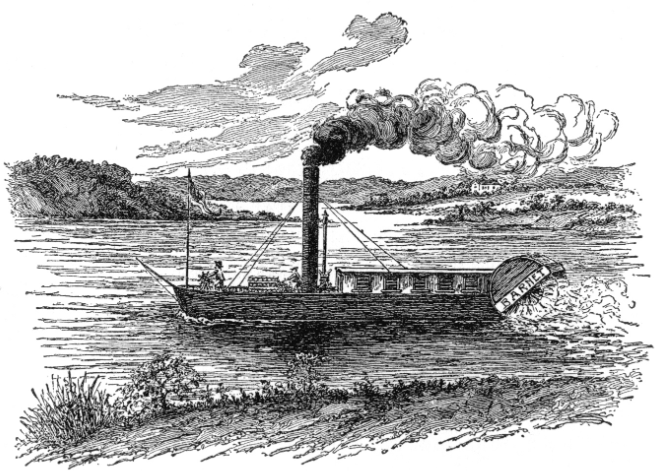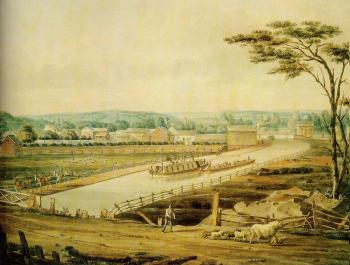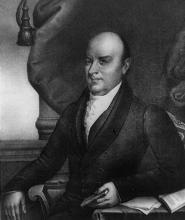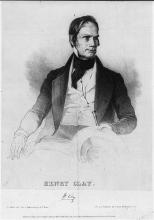The American System
Due to a spike in nationalism after the War of 1812 some members of Congress were seeking ways to unite the country economically. Their intent was to force the U.S. to be more reliant on itself and not on Great Britain. Westerners needed to develop their economy and link it to the North and the South. The American System was proposed.
Clay first used the term “American System” in a speech he gave in 1824. It was a federal policy based on a market economy. Sections of the country would produce specific commodities which they would sell to other regions. (See his 1830 speech: "A System of Real Reciprocity.")
The policy had three main components:
- Transportation – In order to promote trade among the regions, North, South and West, transportation needed to be improved. The American System included financial support for roads, canals, bridges. These improvements to the nation’s infrastructure would facilitate trade and increase accessibility to markets.
- Revenue – Money would be raised by selling public land and imposing tariffs. In addition to raising money, tariffs would protect American products from imports.
- Federal Bank – A strong national currency would assist in interstate trade and make the Bank of the United States more stable. The bank would be used as a depository for federal money collected from the tariffs and land sales.
sixth president of the U.S.
The Whig party led the way for the American System with support from Congressman Henry Clay from Kentucky, John Quincy Adams from Massachusetts and John Calhoun from South Carolina.
Calhoun later withdrew his support because his region believed this system would hurt the South’s economy and favored only the North and the West.
The West opposed the tariff, though Clay argued they should support it, as urban factory workers were potential consumers of western agricultural products. In the end, the West supported the plan, creating increased sectionalism between the regions.
Only portions of the American System were actually put in place, particularly the tariffs, which were opposed by the South. John Calhoun opposed the tariffs, believing it put a financial strain on the South while the North and West profited. He called the tariff, “Tariff of Abomination” and questioned the authority of the federal government to force a state to abide by a law that caused that state harm. Many historians feel that this event was a main reason for the Civil War – the conflict between state’s rights and the rights of the federal government.
Though some areas did receive financial assistance, in the long run, the national system of internal improvements was never adequately funded; the failure was due in part to sectional jealousies and constitutional concerns about such expenditures.
Lesson Overview
In this lesson, students will examine speeches and cartoons relating to the American system. Though their exploration, they will answer some of the following questions:
- What was the American System?
- What role did Henry Clay play in the American System?
- What impact did the American System have on the U.S. during the early to mid-1800s?
- What impact did the American System have on Springfield and the Connecticut River Valley?
- How does the American System set the stage for the Industrial Revolution and sectionalism?
This lesson is broken down into 3 parts; obtaining background knowledge, analyzing primary resources and synthesizing knowledge the American System and how if affected the Connecticut River Valley and Springfield.
Learning Objectives
Know:
- The importance of the American System and what it entailed.
- The influence of Henry Clay, John Quincy Adams and John Calhoun.
Understand:
- The effect of federal policy and how it led to sectionalism
- How local history is connected to national history.
- How to analyze a primary document.
Be able to:
- Make connections between national policy and how it affected various regions.
- Analyze a primary document and infer its intent.
- Understand how the American System set the stage for the Industrial Revolution.
Lesson Procedure
Part 1 – Background knowledge
- Have students read The American System and the Student Essay on the Steamboat Barnet.
- Have students do research on Henry Clay, John Calhoun and John Quincy Adams.
- Who are they?
- Where are they from?
- What influence did they have on the American System? What was their position?
- Did their region of the country benefit? Why or why not?
- The class as a whole should review their responses so that students have an in-depth understanding of the people who were involved in the American system.
Part 2 – The Speeches of Henry Clay
Divide students into pairs and have them analyze sections of Henry Clay's 1830 speech: "A System of Real Reciprocity."
Focus questions:
- What is Clay promoting?
- Does he support nationalism or sectionalism and explain why?
- What effect will it have on the economy, according to Clay?
Part 3 – Cartoon Analysis
Next, have students analyze the Clay cartoon, without showing them the explanation or source information.
Focus questions:
- What is the point of view of the cartoon’s creator? Using the elements of the cartoon, explain your answer.
- What do the labels on the cages represent?
- Drawing on your knowledge of the American System, what can you infer from the caption?
Share the explanation and source information with students:
- Does this change their interpretation of the cartoon? How?
Part 4 – Conclusion
- Based on your background knowledge and the class discussion of Calhoun and Adams how would they have responded to Clay’s speech?
- After reading information on the Connecticut River Valley and the Barnet, what connection did the American System have to improving transportation and trade in Western Massachusetts?
- How did the American System influence growing sectionalism in the country? What affect could this have cohesion and the Union?
Extension activities
Break the class into three groups, each representing one of the regions of the United States – the North, the South and the West. Appoint three students as judges.
- Have a three-way debate, with each side focusing their arguments on their region’s response to the American System.
- Judges will decide who wins the debate and gains the upper hand in designing the American System.
- Follow up discussion questions
- What parts of American System do we see in our government today?
- If the American System was to be implemented today, would the debate be the same or different as it was in the early 19th century?
- Examine the roots of the idea of The American System through the essay: Alexander Hamilton, Founder of the American System.
- Who really should get credit for creating The American System? Besides Hamilton and Clay, who else deserves credit? What about the workers and enslaved people who built and operated the infrastructure and factories of the system?






